James Dayley
Dayley,
Dailey, or Daly is a fairly common name and there are many
unconnected family lines that share the name and are of Irish origin.
This particular family line can be traced back to James Dayley who
was born in 1752 at sea while crossing the Atlantic Ocean from
Ireland. His father, whose name was also James Dayley was from around
Dublin, Ireland. Upon arrival in the American Colonies, they
eventually settled in Pennsylvania. The elder James Dayley served in
the Revolutionary War.
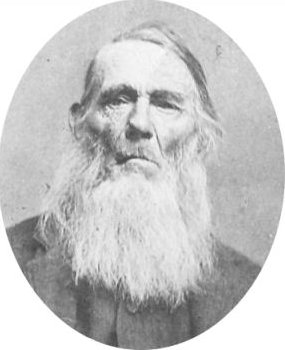
The younger James Dayley married a woman by the name of Margaret in Pennsylvania and among their children was a son they named Jacob. Jacob Dayley was born in 1787 in Bedford, Bedford County, Pennsylvania. Jacob grew up in Pennsylvania where he married Elizabeth Barbara Baker on February 11, 1810 in Bedford. Elizabeth was born June 4, 1791 in Bedford. Prior to her marriage she had been married to Abram Rhodes was left a widow with a young son, Enoch Rhodes.
At some point, Jacob and Elizabeth moved to Belmont County, Ohio. About a year after they were married, Jacob died in a drowning accident. Soon after his death, James Dayley, the subject of this story, was born on March 26, 1811 at Little Pigeon Roost, Belmont County, Ohio.
James' mother remarried and he grew up with four half brothers, including Enoch Rhodes, and one half sister, but no full brothers or sisters. His opportunities for an education were few and fragmentary because he was obliged to support himself at an early age. As a young man, James participated in the Black Hawk Indian War in 1832, (not to be confused with the Black Hawk War in Utah). He cast his first vote in 1832 for Andrew Jackson, when Jackson was elected to his second term as President of the United States.
On February 10, 1834, at the age of 23, he was baptized into the Church of Jesus Christ of Latter-day Saints, the only one of the family to join the Church. Soon after that, on March 18, 1834, he married Isabelle McBride at Richland County, Ohio. Isabelle was born on March 28, 1816 in Lancaster, Fairfield County, Ohio. Prior to marrying James, she was married to his half brother, Enoch Rhodes, who died shortly after they were married.
In the spring of 1835 James and Isabelle, along with her parents Thomas White McBride and Catherine John McBride and their younger children started for Jackson County, Missouri, to join with the Saints. They were accompanied by Isabelle's brothers; James, Amos, and Thomas McBride and their families and her sister, Elizabeth and her husband James McMillen and their family. They traveled for about two months with teams and wagons and arrived in Pike County, Missouri, in the latter part of June. The Church was very much scattered and unsettled, so they remained in Pike County for about a year. While living in Pike County James' and Isabelle's first child, Elizabeth, was born on April 14, 1835. She only lived six months and died on October 20, 1835.
In the spring of 1836, the McBride Family went to Ray County, Missouri and there joined with the Church. They suffered a lot with ague and fever. In September, James and Isabelle, her parents, and siblings and their families moved to Caldwell County, Missouri, and settled about three-fourths of a mile from Haun's Mill on Shoal Creek, about twelve miles due east of Far West. A branch of the Church was organized at Haun's Mill, presided over by David Evans.
In Missouri James become acquainted with the Prophet Joseph Smith and sometimes escorted him as a bodyguard. Joseph prophesied concerning James that if he would be faithful, he would live until he was satisfied with days and look back over a large posterity, even though bullets would fly about him like hail.
It was at Grand River, Caldwell County, Missouri that James' and Isabelle's son, Encoh Rhodes Dayley was born on September 19, 1837. He was named after James' half brother and Isabelle's first husband.
On October 30, 1838, an angry mob of 250 armed men approached the settlement of Haun's Mill. The mob ignored a flag of peace and commenced to massacre the people there. James was among those barricaded inside the mill. Volleys of musket fire poured into the mill, killing many of those inside. James was among five men who escaped by running across the mill dam and an open field while volley after volley was fired at them. Isabelle and the baby hid in the willows along the stream for safety.
Once
out of danger, he discovered that bullets had passed through the
crown and brim of his hat, through his coat between his arm and body,
and through his pant legs, in fulfillment of the prophecy of Joseph
Smith. His father-in-law, Thomas White McBride, was brutally murdered
at that time.
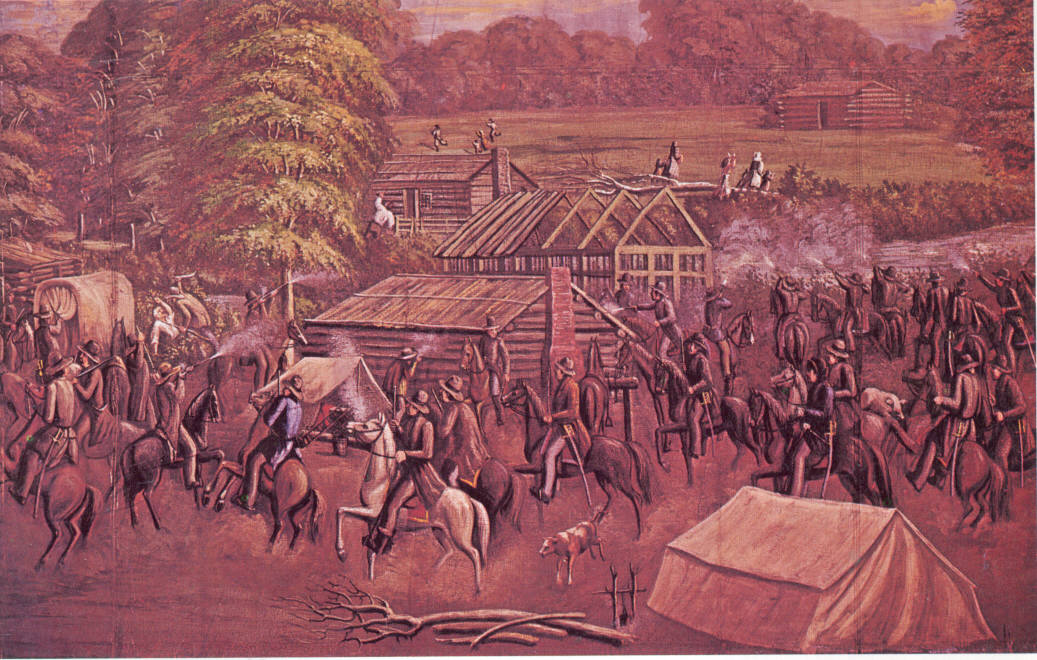
The Haun's Mill Massacre - painting by C.C.A. Christensen. In the left center,
just behind the covered wagon, is a depiction of the murder of Thomas White McBride.
A few rods south of the blacksmith shop was an unfinished well about eight to twelve feet deep, with no water in it. James and his brother-in-law, Amos McBride, and another man, Jacob Myers, were the only able-bodied men available to bury the dead. They carried the bodies of the seventeen victims, one at a time, on a board and dropped them into the well and covered them with dirt to protect them from the herd of hogs the mob was bringing in. James dedicated the well as a grave. He and two other men were taken prisoners and tormented and harassed for a few days and then set at liberty. James was severely beaten. After the massacre, the mob took over the mill, shot their animals and had no sympathy for those who had been widowed.
On February 24, 1839, James and his family gave up their home at Haun's Mill and started for Nauvoo, Illinois. With him were his mother-in-law, Catherine John McBride, along with Isabelle's brothers Amos and James McBride, and another young man, Harrison Severe. In all, their party numbered about thirteen persons. They set out with a team of horses pulling a wagon and a yoke of oxen pulling a two-wheeled cart. The first day, they traveled about nine miles and camped that night in a house that had been vacated by one of the brethren. It was extremely cold.
While camped there, they were informed that the guns the mob had taken from them had been taken to Richmond, in Ray County, and they could get them back by describing them. James and his brother-in-law, James McBride, left the next morning for Richmond, traveling on foot, as no teams were going in their direction. They arrived in Richmond about an hour before sunset. After describing their guns, taking the oath, and paying the required fees (sixty cents), they were directed to a bin in which was stacked several hundred guns. The gun belonging to his father-in-law was not found, but they retrieved their own guns and that of Amos McBride.
Having done all they could, they again turned in the direction of their company. After traveling about ten miles, they stopped at a late hour for the night at the home of Brother Ewell, who had been a good friend to many of the Saints, and had supper. They lodged there for the night and had breakfast the next morning and were on their way at an early hour. After a hard day's trip, just before sunset, they came to a place where they were informed that their company had passed through at about eleven o'clock. Knowing that they were not far behind, they were anxious to press on. They had not eaten since breakfast, so they arranged for dinner for which they paid 12½ cents each.
The country through which they were traveling was sparsely settled. They traveled ten or more miles without seeing a house. They traveled on about eighteen miles through open prairie in the hope that their company had camped at the edge of the prairie, and that they might overtake them, they traveled on. Slowly they trudged on until quite late in the evening, when they saw a campfire about a mile ahead of them in the timbers. They left the road and went in the direction of the fire. When they got to it, they gathered wood to keep the fire going and camped there for the night. Before dawn, the crowing of a rooster let them know there was a house nearby. They went to the house and were given breakfast and then wearily traveled on. At about eleven o'clock that day, they overtook their company, having been separated for five or six days, and traveling an average of forty miles a day.
After a tedious journey and a great deal of exposure, the company arrived in Adams County, Illinois. While at Payson, Adams County, Illinois, James' and Isabelle's third child, Issac Moreley, was born on January 8, 1840. Around the last of April in 1840, James and his company arrived at Nauvoo, Illinois.
In
Nauvoo, James assisted in building the "City Beautiful." He
was a member of the Nauvoo Legion, belonging to Henry Hardin's
company. While living in Nauvoo, two more children were born, Sarah
Ann on October 26, 1841 and George on January 3, 1844.

Nauvoo - "The City Beautiful"
Life in Nauvoo was a welcomed respite from the heartache of Missouri. Nauvoo’s residents, in the midst of building a thriving city and a temple, had some time for and enjoyed participating in recreational activities. They attended the theater, lectures, and balls. There were three choirs and three brass bands. They played ball, wrestled, and pulled sticks. Joseph Smith especially liked to pull sticks and wrestle and was widely hailed as one of the best at both. Wood cutting and quilting bees, cooperative barn and house building, fishing, picking wild berries, braiding, and weaving were practical as well as recreational pastimes that were also popular. James and Isabelle most certainly participated in many of these events.
Life in Nauvoo was generally typical of life in American cities of the nineteenth century. But there were some unique aspects. Perhaps its greatest difference was that most of its citizens’ fondest hopes centered on gathering together according to the principles of Zion, building their holy temple, learning the doctrines of salvation, and seeking the blessings of the Lord.
The tranquility eventually gave way to persecutions and by May of 1844 the Latter-day Saints were again embroiled in an apparently irreconcilable conflict with their neighbors. Then came the fateful day of June 27, 1844 when the Prophet Joseph Smith and his brother, Hyrum were martyred at Carthage, Illinois. The next day their bodies were brought back to Nauvoo. As their bodies laid instate, thousands of people silently filed past their coffins to pay their final respects.
As a long-time friend of the prophet Joseph Smith, James was one of the few who were present at the secret burial of Joseph's and Hyrum's remains. They were buried in the basement of the Nauvoo House to protect their bodies from the mob. After the public funeral, their sand filled caskets were buried in the Nauvoo Cemetery.
With the death of the Prophet, a crisis arose as to who should succeed him as the leader of the church. Sidney Rigdon, the estranged First Counselor in the First Presidency returned from self imposed exile to proclaim himself the the guardian of the church. At the same time, the Twelve Apostles who had been serving missions returned to Nauvoo to take charge and to bring order. As the debate continued and a meeting was called for August 8th. It is uncertain whether or not James and Isabelle were present at that meeting in the grove. But the events of that meeting, in which the mantle of the Prophet Joesph Smith fell on Brigham Young, had a profound affect on the Dayleys as they sided with the main body of the Saints in accepting Brigham Young and the Twelve Apostles as the rightful governing body of the Church.
Personal
tragedy knocked at the door of James and Isabelle in December of 1844
when their eleven month old son, George died. While still in grief
over this loss, 3½ year old Sarah Ann died on March 24, 1845 in
Nauvoo. In the fall of 1845 the emptiness of their losses were eased
with the joy of the birth of Heber Chase Dayley on September 5, 1845
in Nauvoo. 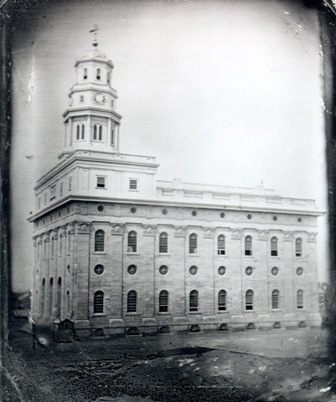
The Nauvoo Temple - 1846
During the winter of 1845 and 1846 Brigham Young and the Apostles began making plans and preparations to evacuate Nauvoo the following spring. Despite the fact, work continued on the Nauvoo temple in order to complete it before leaving. In February the temple was completed and the decision was made to begin the exodus earlier than planned. James and Isabelle received their endowments in the Nauvoo Temple on February 6, 1846.
In order to keep affairs in the best possible conditions, it was necessary to organize the Church into companies. First headed by a captain, would be a company of one hundred families. These families divided into two companies of fifty families each. Over each of these was a captain. These fifties were divided into companies consisting of ten families, each ten having a separate captain. James Dayley was the captain of the ten which consisted of Isabelle's brothers and sisters and their families.
As the Saints were again driven from their homes, the Dayleys left Nauvoo in April 1846 along with the families of Isabelle's siblings, directing their course westward. They all loaded what they could take with them and left with a span of horses of very inferior quality pulling a small wagon, and a yoke of oxen pulling another wagon.
The first day, they moved to the banks of the Mississippi River where they unloaded everything at the river. Then with the teams they returned to Nauvoo for another load. By evening the family was all together again. This was the way they traveled each day – hauling everything in two trips. They only traveled about twenty-five miles in ten days, camping together every night.
They stopped at Farmington, Van Buren County, Iowa. There the company took a job of clearing land during the summer. Their wages was about twenty-five cents per day, each. In September 1846, they left Farmington, and moved down the Des-Moines River to Tom's Mill, where they stopped. There was a great deal of sickness in the company during the fall and winter – resulting in the death of three children. At one time for about ten days, only one man in the company was able to work. The company shared everything in common. All that was earned was shared equally with the rest.
About
the first of May 1847, the company with the exception of three
families resumed the journey west. They started from Tom's Mill, with
three yoke of oxen, and three wagons. Though they could now travel
with much less trouble than before, they were not able to carry
sufficient provisions for the company for any length of time.

They traveled about sixty miles and stopped in Apponoose County, Iowa as it was impossible to proceed any further. Their teams were not sufficient to draw their families and provisions across the plains as there would be but little chance to obtain provisions. With the Great Plains before them extending west to the Pacific Ocean, they did not know where they were to make their final home. The orders were to 'Move West.' Many companies had already gone ahead; but they had not.
The frontier settlers in Apponoose County, among whom they found themselves, were filled with hatred towards the Mormons. Bitter threats were made against them, and they were watched on every hand. A council was held by the little company. It was evident that they could not have gone any further and had to stop. It was necessary that they seek the friendship of their worst enemies.
They made camp. Some commenced to improve the land while others sought work from the settlers in order to get means to buy provisions for their families. They had not been there long when they gained a very good reputation. The work they contracted to do was done well. Soon they could get work anywhere, and were consequently able to make themselves quite comfortable.
No time was lost in building cabins for the winter. The next spring They commenced farming the ground which they had improved. The object was to gain the means with which to travel west – and the sooner this could be accomplished the better.
While in Appanoose County several children were born. James and Isabelle had two sons during that time; Thomas James Dayley who was born on August 14, 1847 and James Carlos Dayley was born on January 19, 1850. Despite these births, the company was considerably reduced in number.
On the 17th day of May 1850, having disposed of their homes and farms in Aponoose County, they again started west. After traveling about three hundred miles they arrived in Kanesvllle, Iowa. It took them four years to come across Iowa and rejoin the a body of Saints.
After a few days, it was decided that the entire company could not safely venture to cross the plains that season. A council was held where it was decided that two families could go on, but the rest would have to stay there, until they could obtain more means. James and Isabelle Dayley, William and Catherine McBride Pope with their families, and Mary McBride Biddlecome and her children, were left to follow on as soon as possible.
They remained at Kanesville until 1852 where James served as bishop. It was during this time that their son, Jacob, was born on April 11, 1852 at Keg Creek, Pottawattamie, Iowa.
On June 26, 1852 the Dayley Family set out across the plains with the John B. Walker Company which consisted of 258 people. The Dayley family consisted of James (41), Isabelle (36), Enoch Rhodes (14), HeberChase (6), Thomas John (4), James Carlos (2), and (3 months). At one point there was a cholera outbreak that took the lives of thirteen members of the company. By 1852 it was a somewhat better experience than those who first blazed the way. Other than the usual hardships, the trek across the plains was not as nearly as bad as the difficulties the families endured coming across Iowa. They arrived in Salt Lake City on October 2, 1852. From there they were sent to settle in Grantsville, Tooele County, Utah where James bought a farm near Harrison Severe, his brother-in-law.
Their trials were not over, for there was hunger and trouble with the Indians. Two more children were born in Grantsville; Isabelle Rebecca on October 14, 1853 and Nancy Vilate on July 17, 1856. One summer the grasshoppers came so thick they darkened the sun and destroyed the crops. At the age of 2, Nancy Vilate died in 1858.
Isabelle
was in very bad health and hired Caroline Hardy, a sixteen year old
young woman, to help care for the family. After
Caroline had worked in the Dayley home for a long time, Isabel
realized that she would not get well, and she was worried about her
five youngest children being without a mother. She asked
her husband to marry Caroline in order to
help him raise their children. James
who was twenty-nine years older than Caroline, talked
with her mother, and she consented to the marriage.
They were married
on March 18, 1857. Both
Isabelle and Caroline were sealed to him by Heber C. Kimball in the
President's office that day.
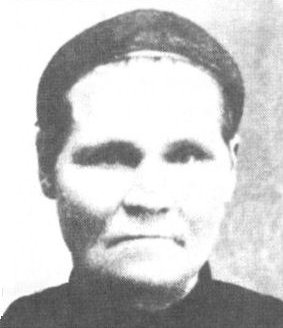
Caroline Elvira Hardy Dayley
Caroline Elvira Hardy was born on March 9, 1840, in St. George, Augusta County, Maine. She was the daughter of Zachariah Hardy and Elvira Philbrook Hardy. Caroline was only a small child of about three when her parents joined. Caroline was not in love with James, but she had great respect for him. Their first child, Elisha Brunson, was born September 6, 1859 in Grantsville.
Isabel only lived four more years after James and Caroline were married. Caroline cared for Isabell until she died on January 11, 1861 at the age of 44 and was buried in Grantsville. They had been married for 28 years and had eleven children, four of which had died as children.
James and his family moved to Richmond in Cache Valley in 1862 where his son Enoch had been called by the church leaders to help with the settlement. Five Children were born to James and Caroline while they were living in Richmond; twins Barbara Ellen and Dorcas Hellen on March 31, 1862, Nancy Elizada was actually born in Grantsville on March 10, 1864, Zachariah Hardy on January 14, 1866, and William Francis who was born in Morgan, Weber County, Utah on 27 October 1867. Nancy Elizada died in October 1866 at two and half.
The Dayleys moved back to Grantsville in 1868 where they lived for the next eleven years. During that time Zachariah Hardy died on December 13, 1868 just short of turning three years old, and William Francis also died on December 24, 1868 at one year old. Six more children were born in Grantsville; Joseph Hyrum on September 8, 1869, James Nephi on January 27, 1872, and Eliza Elvira on December 29, 1873, Mary Ann on September 8, 1875, Sylvia on April 17, 1877, and Abram on January 10, 1879.
In the spring of 1878, President Francis M. Lyman, President of the Tooele Stake, sent James and four of his sons, Jacob, Heber, Thomas, and Elisha, to look for a valley they had heard about. The group traveled on the west side of the Great Salt Lake and northward to the hills above Albion, Idaho. The Oregon trail followed the Snake River to the north while the California Trail cut off at Raft River and went through nearby Almo and the City of Rocks and on into Nevada. To those pioneers the area was a foreboding area to be passed through quickly. Two wagon trains had been attacked and massacred in the vicinity. Only the the numerous jackrabbits contended with the Indians for possession of the dry sagebrush covered land until the 1870s when a half-dozen stockmen established themselves in the valley.
As
the group stood on top of the mountain and looked down into Goose
Creek Valley, they saw waving grass and the valley dotted with
antelope and deer. (Sagebrush did not take over until after the
valley had been overgrazed and a drought.) The group continued on and
came down into what is called Little Basin, near Oakley, Idaho. They
found a few cabins owned by cattlemen from Nevada who used the valley
as a summer grazing land. They
liked what they saw and each staked out a 160 acre homestead and
bought one of the cabins and a cow. Because of an
Indian scare at that time, word was sent for them to return home to
Grantsville.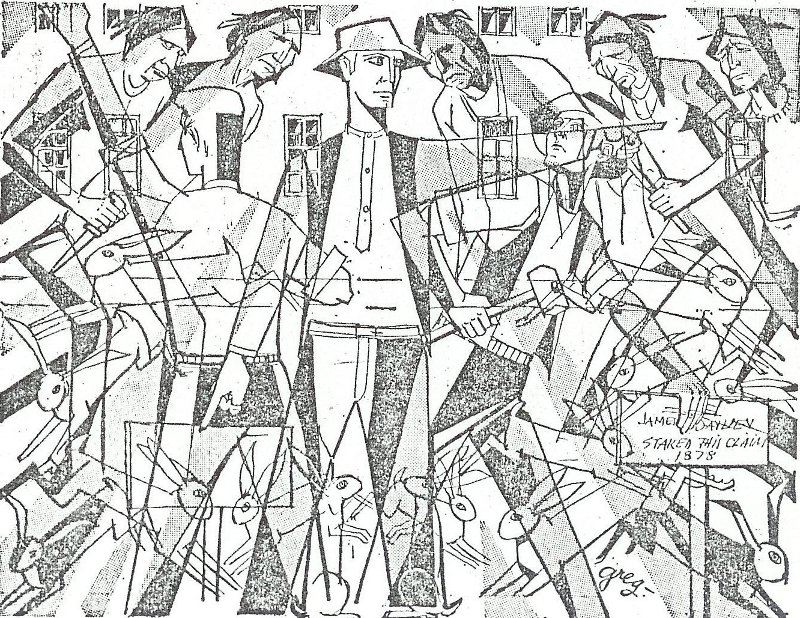
James Dayley stakes his claim
James returned to Basin in 1879 with his family and the families of his sons plus a few others. The first year they raised some wheat and potatoes and a vegetable garden. He still had the cow that he bought the previous year. They had taken one plow with them and made a harrow out of willows. To harvest their wheat, they used a canvas and flailed the heads out with willows, and then ground it in a coffee grinder for flour. They raised two crops without a thresher, and then three of the men acquired a threshing machine. Within a year after the Dayleys settled in the Little Basin, other people began arriving to stake their claims. They camped along the creek and the whole group would build a house for one and then another until all had homes.
About the same time Cassia County was created by the Idaho Territorial Legislature on February 20, 1879, by partitioning Owyhee County, with the county seat at Albion. At that time, Cassia County included all of Cassia and Twin Falls Counties.
At a conference held at Centerville, Utah on March 26, 1880, a branch, known as the Goose Creek Branch of the Tooele Stake was organized. William C. Martindale was President, with George Whittle as first counselor and Enoch Rhodes Dayley as second counselor. These three men, along with Francis M. Lyman, president of the Tooele Stake, then came to the Oakley valley for the purpose of purchasing water rights, which were held by certain stockmen, and to prepare for a general colonization.
The organization of the branch was completed May 9, 1880 at the home of Thomas Dayley in Little Spring Basin, five miles east of Oakley. There were fourteen members present at that meeting. The branch included Basin and Oakley. Meetings were held alternately at Basin and Oakley, Elder Dayley presiding at Basin and Elder Martindale presiding at Oakley.
All
was not peace and quiet in those early days because there were Indian
scares, and the cattlemen caused trouble as their summer grazing land
was taken away by the homesteaders. 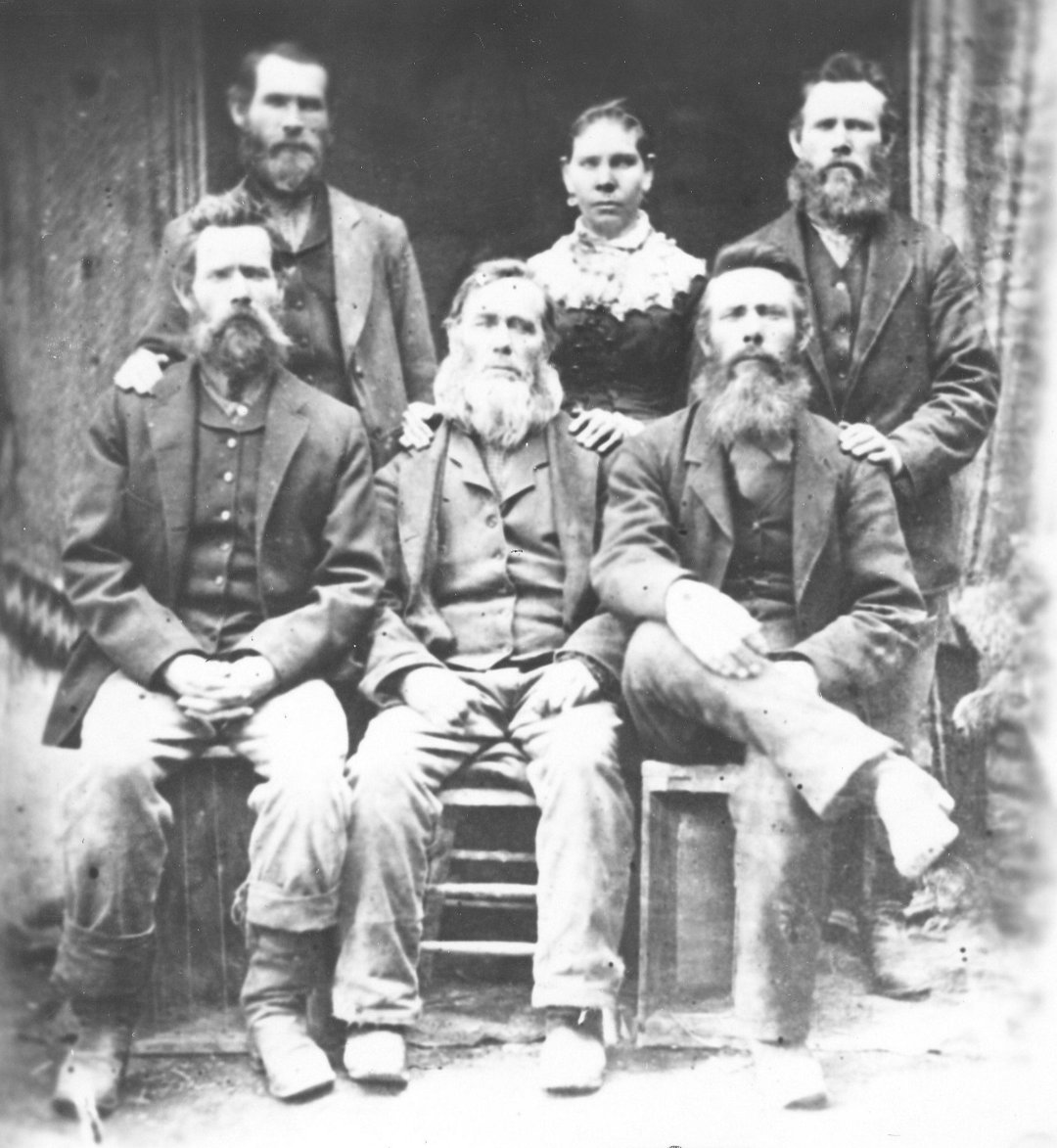
Standing: Jacob Dayley, Isabelle Dayley Phillips, and Thomas Dayley.
Seated: Heber Dayley, James Dayley, Sr., and Enoch Rhodes Dayley.
One year in the early days of Basin, it was discovered early in the spring that there were great numbers of cricket larva in the ground ready to hatch, many times more than had ever been noted before. The people knew that when they did come out of the ground they would eat up every bit of vegetation in sight, which would mean disaster for all concerned. They called a day of fasting and prayer, believing that the Lord would deliver them from the menace. The next day it rained, softening the ground and the crickets came out by the millions, the ground crawled with them. That night it froze, killing all of the crickets.
Two more children were born to James and Caroline in Basin. Elsie Louisa was born on June 17, 1881 and Lucy on May 4, 1883. Two of their children also died in Basin as well. Abram died on October 10, 1881 at the age of two. Nine days later, Eliza died on October 19, 1881 at the age of six. In all, Caroline had fourteen children, five of which died as children. That made James the father of a total of twenty five children, seventeen lived to maturity.
More and more people heard the favorable reports from the Dayleys moved to to Basin and Oakley; mostly people from Tooele and Grantsville. In 1882 the Goose Creek Branch became the Cassia Ward, which included all of South Central Idaho. At that time it was taken from the Tooele Stake and was made as part of the Box Elder Stake.
At a special conference held in Oakley, Cassia County, Idaho on Saturday November 19, 1887, the Cassia Ward became the Cassia Stake of Zion, embracing the saints who had settled in South Central Idaho. On Tuesday, November 22, 1887 at a special meeting held at Spring Basin, the branch of the church previously established there was organized as the Basin Ward with Enoch Rhodes Dayley as the Bishop.
Not only was Cassia County growing, settlements had been established all along the Snake River. Ranching, farming, and mining drew settlers to all regions of the Territory. On July 3, 1890 Idaho was granted statehood.
James was active and faithful in the Church all his life, serving as a seventy, high priest, bishop, and patriarch. In business he was diligent and prospered. There is some indication that he was a carpenter as well as a farmer.
In
1902, a grand celebration was held on the 91st anniversary of his
birth. His birthday had been celebrated for the previous 20 years,
with family having a "get together”. But everyone agreed that
this was the grandest of all. According to an article in the Oakley
Eagle dated April 2, 1902 it was held in the Basin Ward meetinghouse,
and included bounteous food and a program of singing and speeches,
with more of his posterity gathered together than ever before.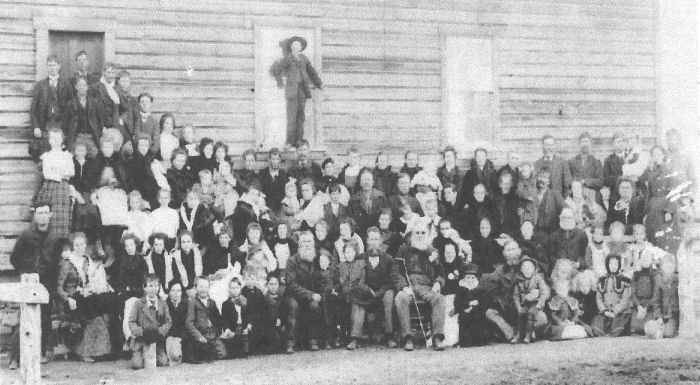
The James Dayley family on his 91st birthday
The reporter covering the event described the prayer given by the honoree at the beginning of the meal as "one of the most earnest and sweetest little prayers that we have ever heard." At the close of the celebration, a family picture was taken. Over 250 descendents attended this event. He was known to his family as "Grandpap." At the time of this celebration, he was thought to be the oldest living member in the Church, having been in the Church for 68 years.
It was written of him at this time. "In the 91 years of his existence, he has endured much, but through all his great trials, his firm belief and ardent love for the gospel has always been his great comforter. When his trials seemed the hardest to bear was when he clung closer to his convictions, and never once did he falter."
Some of James' family were sealed to him in the Logan Temple on October 21, 1891. Other sealings were performed in the Logan Temple on May 24, 1893. Then on June 20, 1905, the remainder of his family were sealed to him in the Salt Lake Temple. On the way back from that trip, he said that he was ready to die now that his temple work was done.
Soon after this, be became ill and one day was found wandering about the field. His son-in-law, Jack Hunt, brought him in. He was put to bed and passed away after about a week, on July 23, 1905, at the age of 94. Truly, the other part of the prophecy of the Prophet Joseph Smith came to pass as James Dayley lived to be "satisfied with days" and could look back over a large posterity. His tombstone in the Basin cemetery says simply, "Resting till the glorious resurrection morn."
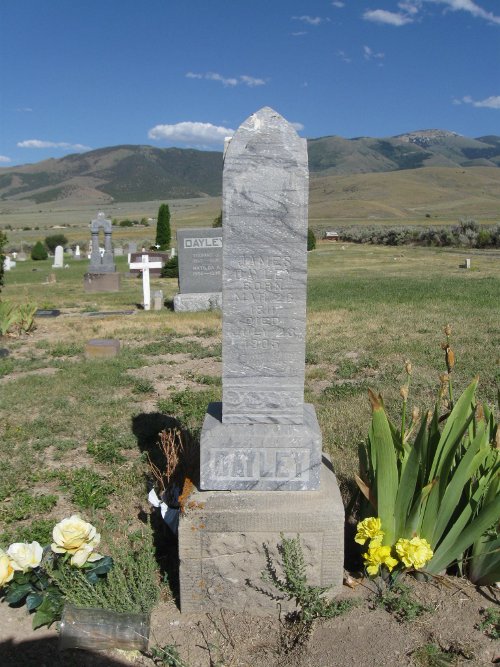 |
* * * * * * * * *
The main source of this story is from a history of James Dayley compiled and edited by Eunice Frost Read.
Other parts are from an autobiography of James McBride, The life story of Enoch Rhodes Dayley, and an account of Caroline Elvira Hardy Dayley written by Mary Edith Fairchild Gavin.
The parts about life in Nauvoo come from the CES manual “Church History in the Fulness of Times.